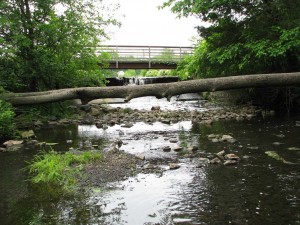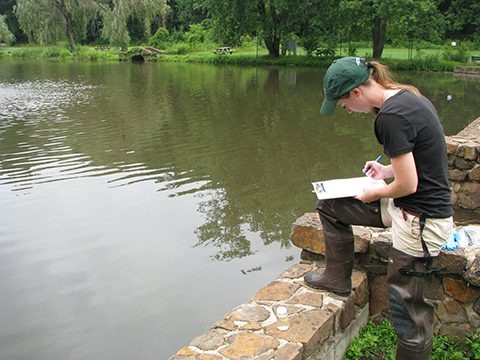

LB2M, located just downstream from Kitchell Pond, met the NJ state standard for E. coli on 6/17/2015 after recent rains.
For the second year in a row, GSWA is monitoring E. coli levels at stream and pond sites around the Great Swamp watershed. E. coli bacteria is an indicator of fecal pollution from warm blooded animals (like people, dogs, and birds). Fecal pollution can contain harmful viruses that can cause health problems for us and our pets when we are exposed to it. Because of these potential health impacts, our monitoring sites focus on areas where people or pets are coming into contact with the water through fishing, kayaking, splashing, and other recreational activities. (Note that official swimming beaches are already being monitored for E. coli under state regulations.)
In case you missed it, we have had quite a bit of rain recently (approximately 0.3-0.6” between Monday and Wednesday morning, lots more since the end of May). You may recall from a blog post last summer that rain can increase E. coli levels in streams. Rain water running over the landscape (also known as stormwater runoff) can pick up any fecal matter on the land and carry it into a nearby water body.
The E. coli levels we saw at all sites from this week’s samples (collected on 6/17) were similar to last year’s samples collected after recent rain. 10 out of 16 sites exceeded standards for high levels of E. coli. The sites that met the standard are almost all headwaters sites. Being located in the headwaters of a stream, there is a limited amount of land draining to those sites, which lessens impacts from stormwater runoff.
There is one exception to the pattern of lower E. coli in headwater sites. Loantaka Brook below Kitchell Pond (site LB2M, in Loantaka Brook Reservation) met the standard, and it is approximately ¼ of the way down from where Loantaka Brook starts. In contrast, LB3 just upstream of Kitchell Pond had E. coli levels more than 3 times higher than LB2M. Although LB2M is not a headwaters site, Kitchell Pond itself may be playing a role in reducing downstream E. coli levels. This is the first year we are monitoring E. coli both immediately upstream and downstream from Kitchell Pond, so it will be interesting to see how the Pond impacts E. coli throughout the 5-week collection period.
Samples will continue to be collected at all monitoring sites through July 15. To see a map of monitoring sites, click here. To see results from all sites for the first week, click here.
